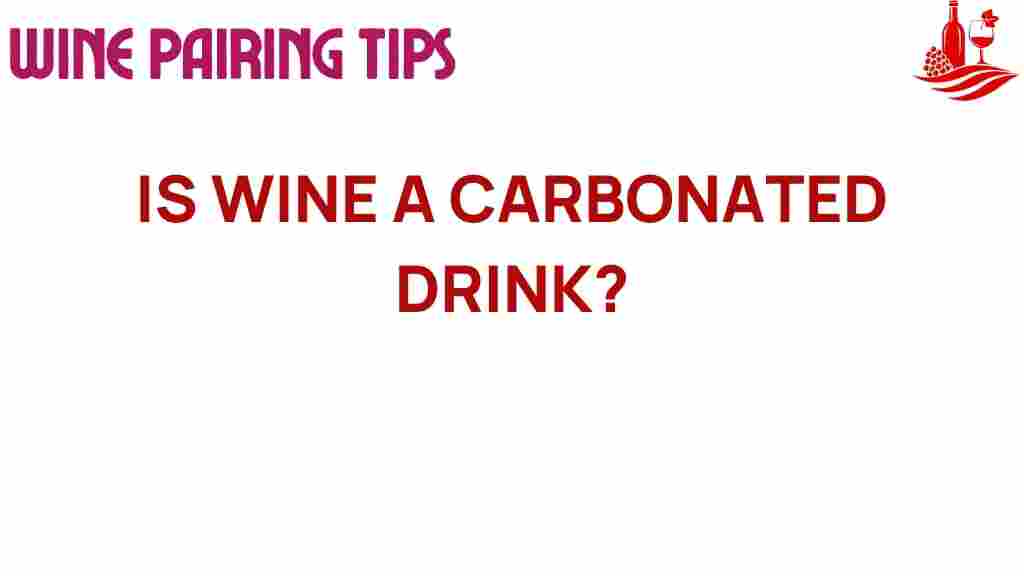Is Wine a Carbonated Drink? Unveiling the Bubbles Within
When it comes to the world of beverages, wine holds a special place in many cultures. It’s celebrated for its complex flavors, rich history, and the diverse types it encompasses. However, a common question arises: Is wine a carbonated drink? To answer this, we need to delve into the intricacies of wine production, the role of carbonation, and the fascinating category of sparkling wine.
Understanding Carbonation in Wine
Carbonation refers to the presence of dissolved carbon dioxide (CO2) gas in a liquid, which creates bubbles. While most wines are still (non-carbonated), certain types of wine, particularly sparkling wine, are infused with carbonation. This carbonation can occur naturally during fermentation or be added artificially.
The Fermentation Process
The production of wine involves fermentation, a natural process where yeast converts sugars in grape juice into alcohol and carbon dioxide. In still wines, the CO2 produced escapes into the atmosphere, leaving the wine flat. However, in sparkling wines, the carbonation is trapped, creating the delightful bubbles that many wine enthusiasts adore.
Types of Carbonated Wines
There are several types of wine that incorporate carbonation, each with unique characteristics:
- Champagne: Originating from the Champagne region of France, this iconic sparkling wine is known for its fine bubbles and complex flavors, often achieved through a secondary fermentation in the bottle.
- Prosecco: An Italian sparkling wine that is typically lighter and fruitier than Champagne. It undergoes a different fermentation method called the Charmat method, which emphasizes freshness.
- Cava: A Spanish sparkling wine made using traditional methods similar to Champagne. Cava offers a range of flavors, from fruity to nutty.
- Frizzante: This term refers to lightly sparkling wines, which have a lower level of carbonation compared to fully sparkling varieties.
The Role of Bubbles in Wine Flavor
The presence of bubbles in sparkling wine significantly influences its flavor profile. Here’s how carbonation affects the tasting experience:
- Texture: The bubbles create a unique mouthfeel, adding liveliness and a sense of freshness to the wine.
- Aromatics: Carbonation can enhance the release of aromas, making the wine more fragrant.
- Food Pairing: The acidity and effervescence of sparkling wines make them versatile for pairing with various foods, from appetizers to desserts.
Exploring Wine Culture and Carbonation
Wine culture varies around the world, but sparkling wines often take center stage during celebrations and special occasions. In many cultures, the act of opening a bottle of sparkling wine is synonymous with joy and festivity.
Additionally, the enjoyment of bubbles in wine has led to the rise of various wine cocktails, where sparkling wine serves as a base for creative mixes.
How to Choose Carbonated Wines
When selecting a carbonated wine, consider the following factors:
- Flavor Profile: Determine whether you prefer fruity, floral, or more complex flavors.
- Occasion: Choose a sparkling wine that fits the event, whether it’s a casual gathering or a formal celebration.
- Price Range: Sparkling wines can vary widely in price. Explore options within your budget while seeking quality.
Step-by-Step Process of Making Sparkling Wine
Creating sparkling wine involves several key steps:
- Harvesting: Grapes are carefully picked at the right ripeness to ensure optimal sugar and acidity levels.
- Pressing: The grapes are pressed to extract juice, which is crucial for fermentation.
- Primary Fermentation: Yeast is added to the grape juice to initiate fermentation, converting sugars into alcohol.
- Secondary Fermentation: For traditional sparkling wines, a mixture of sugar and yeast is added to the base wine, which is then bottled. This creates carbonation as the CO2 is trapped.
- Riddling: Bottles are gradually turned to collect sediment in the neck.
- Disgorging: The neck is frozen, and the sediment is removed before adding a dosage of sugar and wine.
- Corking: Finally, the bottle is sealed with a cork, ready to be enjoyed.
Troubleshooting Common Issues with Carbonated Wine
While enjoying sparkling wine, you might encounter some common issues:
- Flat Bubbles: If your sparkling wine has lost its fizz, it may have been stored incorrectly. Always keep bottles upright and sealed until you’re ready to drink.
- Too Much Foam: When pouring, tilt the glass to minimize excess foam. Pour slowly to maintain the bubbles.
- Flavor Imbalance: If the wine tastes overly sweet or lacks acidity, it might not suit your palate. Experiment with different brands and styles to find your preference.
Conclusion
So, is wine a carbonated drink? The answer depends on the type of wine in question. While most wines are still and non-carbonated, sparkling wines are a delightful exception, celebrated for their bubbles and vibrant flavors. Whether you’re savoring a glass of Champagne, Prosecco, or Cava, the effervescence adds a layer of enjoyment to the wine experience.
As you explore the world of wine, consider the role of carbonation and the rich culture surrounding sparkling wines. With their unique characteristics and celebratory nature, carbonated wines offer something special for every wine lover.
For more information about the different types of wine and how to enjoy them, check out our guide on wine types and their characteristics. To learn more about the fascinating history of wine and its cultural significance, visit Wine Enthusiast.
This article is in the category Varietals and created by Wine Pairing Tips Team
